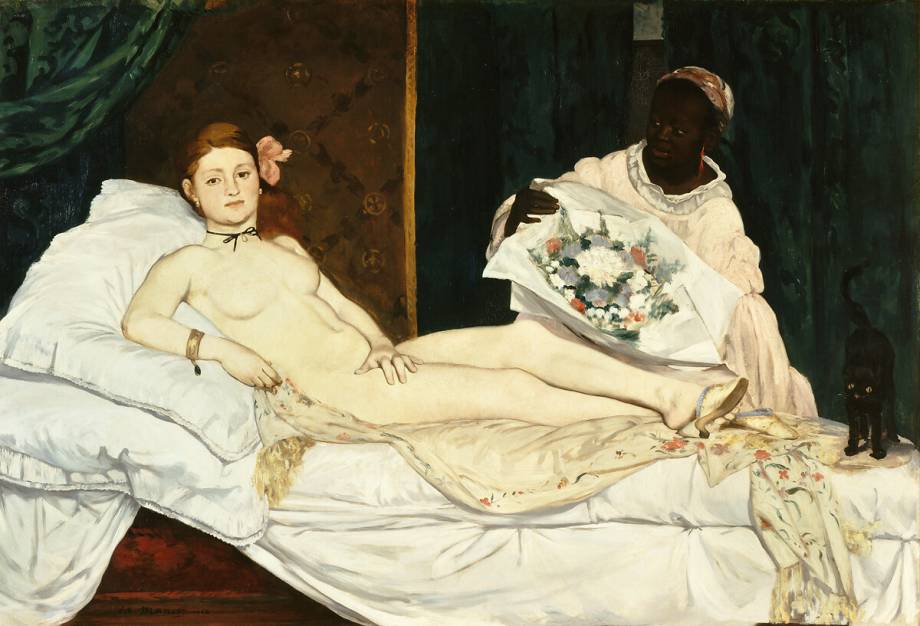Shop art print and framed art Olympia by Edouard Manet
Customise
Your art print
Olympia OF Edouard Manet
Olympia
Edouard Manet's Olympia: a revolution in nineteenth-century art
First shown in 1865 at the Paris Salon, Edouard Manet's Olympia is a major and controversial work of modern painting. Dealing with the feminine nude, this famous painting marked a turning point in the history of art by breaking with the academic conventions of the time. Here are the different facets of this painting, which continues to provoke debate and admiration.
A daring representation of the female nude
As soon as it was presented to the public, Manet's Olympia caused a veritable scandal. The main reason for this outrage lay in the way the artist chose to depict the nude woman. Contrary to the pictorial tradition that favoured an idealised and prudish approach to the female body, Manet offered a more realistic and assumed vision of nudity.
The model in Olympia, Victorine Meurent, is shown reclining on a bed, dressed only in a bracelet, a pair of mules and a ribbon around her neck. Her frank, direct gaze appeals to the viewer, while her relaxed attitude shows a certain casualness. This novel approach to the female nude deeply shocked the artist's contemporaries, who saw it as provocative and an affront to public decency.
A daring composition
In addition to the realistic treatment of Victorine Meurent's body, the very composition of Olympia shows a desire to break with established codes. For example, the various elements of the painting are arranged to create a striking contrast between the dark and light colours. The black background and white sheet on which Olympia lies accentuate the radiance of her skin, while the flowers (no doubt offered by an admirer of Olympia's) are reminiscent of traditional still lifes.
Between allusion and transgression: the Olympia's artistic references
Despite its provocative nature, Manet's Olympia is part of a long pictorial tradition of the female nude. In particular, the artist draws on the works of great masters such as Titian and Goya to construct his painting. However, he was not content to simply take up the classical codes of painting: he subverted and reinvented them to offer a new and resolutely modern vision of the woman.
- Titian's Venus of Urbino: one of Manet's main sources of inspiration for Olympia was undoubtedly The Venus of Urbino, a famous canvas by the Venetian painter Titian. This work depicts a nude woman lying on a bed, in a pose similar to that of Olympia. However, the treatment of the body and face differs greatly between the two paintings: where Titian's Venus is imbued with sensuality and gentleness, Olympia displays a certain provocation and a desire to make a statement.
- Goya's La Maja desnuda: another major reference for Manet, Spanish painter Francisco Goya's La Maja desnuda also features a nude woman reclining on a bed. Her face shows a provocative smile and a languid pose. The Spanish artist had designed another version of this painting: La Maja vestida, creating a subversive game, with painting allowing the painter to undress his model and stage her desire.
The role of secondary characters
In the composition of Olympia, two secondary characters occupy an important place: a black maid and a black cat. These elements help to accentuate the transgressive nature of the work by introducing symbols of social domination and mystery.
A manifesto of modernity in painting
Beyond its provocative dimension, Edouard Manet's Olympia above all embodies an artistic revolution. By refusing to conform to academic rules and daring a realistic and assertive representation of women, Manet paved the way for a new generation of artists. His aesthetic and thematic choices marked the beginning of modernity in painting, foreshadowing the Impressionist and Post-Impressionist movements that were to follow.
A true symbol of the transition from classical to modern art, Olympia continues to fascinate and question through its strength and audacity.
This artwork is a painting from the classical period. It belongs to the impressionism style.
« Olympia » is kept at Musée d'Orsay, Paris, France.
Find the full description of Olympia by Edouard Manet on Wikipedia.









































